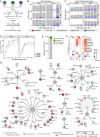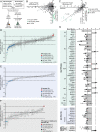Proteomic and genetic analyses of influenza A viruses identify pan-viral host targets
- PMID: 37758692
- PMCID: PMC10533562
- DOI: 10.1038/s41467-023-41442-z
Proteomic and genetic analyses of influenza A viruses identify pan-viral host targets
Abstract
Influenza A Virus (IAV) is a recurring respiratory virus with limited availability of antiviral therapies. Understanding host proteins essential for IAV infection can identify targets for alternative host-directed therapies (HDTs). Using affinity purification-mass spectrometry and global phosphoproteomic and protein abundance analyses using three IAV strains (pH1N1, H3N2, H5N1) in three human cell types (A549, NHBE, THP-1), we map 332 IAV-human protein-protein interactions and identify 13 IAV-modulated kinases. Whole exome sequencing of patients who experienced severe influenza reveals several genes, including scaffold protein AHNAK, with predicted loss-of-function variants that are also identified in our proteomic analyses. Of our identified host factors, 54 significantly alter IAV infection upon siRNA knockdown, and two factors, AHNAK and coatomer subunit COPB1, are also essential for productive infection by SARS-CoV-2. Finally, 16 compounds targeting our identified host factors suppress IAV replication, with two targeting CDK2 and FLT3 showing pan-antiviral activity across influenza and coronavirus families. This study provides a comprehensive network model of IAV infection in human cells, identifying functional host targets for pan-viral HDT.
© 2023. Springer Nature Limited.
Conflict of interest statement
The Krogan Laboratory has received research support from Vir Biotechnology, F. Hoffmann-La Roche, and Rezo Therapeutics. N.J.K. has previously held financially compensated consulting agreements with the Icahn School of Medicine at Mount Sinai, New York and Twist Bioscience Corp. He currently has financially compensated consulting agreements with Maze Therapeutics, Interline Therapeutics, Rezo Therapeutics, and GEn1E Lifesciences, Inc. He is on the Board of Directors of Rezo Therapeutics and is a shareholder in Tenaya Therapeutics, Maze Therapeutics, Rezo Therapeutics, and Interline Therapeutics. The García-Sastre laboratory has received research support from Pfizer, Senhwa Biosciences, Kenall Manufacturing, Avimex, Johnson & Johnson, Dynavax, 7Hills Pharma, Pharmamar, ImmunityBio, Accurius, Nanocomposix, Hexamer, N-fold LLC, Model Medicines, Atea Pharma, Applied Biological Laboratories and Merck, outside of the reported work. A.G.-S. has consulting agreements for the following companies involving cash and/or stock: Vivaldi Biosciences, Contrafect, 7Hills Pharma, Avimex, Vaxalto, Pagoda, Accurius, Esperovax, Farmak, Applied Biological Laboratories, Pharmamar, Paratus, CureLab Oncology, CureLab Veterinary, Synairgen and Pfizer, outside of the reported work. A.G.-S. has been an invited speaker in meeting events organized by Seqirus, Janssen, Abbott and Astrazeneca. A.G.-S. is an inventor on patents and patent applications on the use of antivirals and vaccines for the treatment and prevention of virus infections and cancer, owned by the Icahn School of Medicine at Mount Sinai, New York, outside of the reported work. The Hultquist laboratory has received prior funding support from Gilead Sciences, and J.F.H. has a financially compensated consulting agreement with Merck. D.L.S. has a consulting agreement with Maze Therapeutics. M.B. is a financially compensated scientific advisor for GEn1E Life Sciences. K.M.S. has consulting agreements for the following companies involving cash and/or stock compensation: Black Diamond Therapeutics, BridGene Biosciences, Denali Therapeutics, Dice Molecules, eFFECTOR Therapeutics, Erasca, Genentech/Roche, Kumquat Biosciences, Kura Oncology, Merck, Mitokinin, Petra Pharma, Rezo Therapeutics, Revolution Medicines, Type6 Therapeutics, Vevo, Vicinitas and Wellspring Biosciences (Araxes Pharma). J.C.-S. is a former employee and stockholder of Synthego. While not directly relevant to this study, C.F.B. is a scientific advisor for Axion BioSystems, M.L.S. has a financially compensated consulting agreement with Calibr, and S.P. is employed by Roivant Sciences, Inc. S.P. also holds stock compensation from Roivant Sciences and AbbVie. The remaining authors declare no competing interests.
Figures






References
-
- Putri WCWS, Muscatello DJ, Stockwell MS, Newall AT. Economic burden of seasonal influenza in the United States. Vaccine. 2018;36:3960–3966. - PubMed
-
- Dawood FS, et al. Estimated global mortality associated with the first 12 months of 2009 pandemic influenza A H1N1 virus circulation: a modelling study. Lancet Infect. Dis. 2012;12:687–695. - PubMed
-
- Centers for Disease Control and Prevention (CDC Update: influenza activity--United States, 2003-04 season. MMWR Morb. Mortal. Wkly. Rep. 2004;53:284–287. - PubMed
Publication types
MeSH terms
Substances
Grants and funding
- R21 AI161104/AI/NIAID NIH HHS/United States
- U19 AI142733/AI/NIAID NIH HHS/United States
- U01 HG011172/HG/NHGRI NIH HHS/United States
- T32 GM145460/GM/NIGMS NIH HHS/United States
- U19 AI135990/AI/NIAID NIH HHS/United States
- F32 CA239333/CA/NCI NIH HHS/United States
- P30 AR070549/AR/NIAMS NIH HHS/United States
- U01 AI035039/AI/NIAID NIH HHS/United States
- T32 CA108462/CA/NCI NIH HHS/United States
- U19 AI106754/AI/NIAID NIH HHS/United States
- U19 AI135972/AI/NIAID NIH HHS/United States
- 75N93021C00014/AI/NIAID NIH HHS/United States
- U01 HG011181/HG/NHGRI NIH HHS/United States
- U01 HL146240/HL/NHLBI NIH HHS/United States
LinkOut - more resources
Full Text Sources
Medical
Molecular Biology Databases
Miscellaneous

